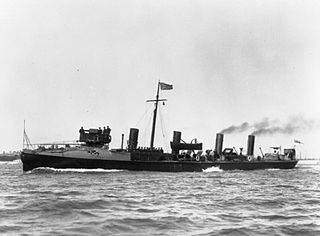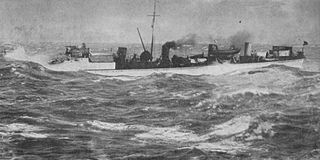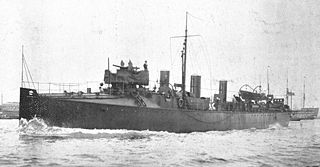
The A class as designated in 1913 was a heterogeneous group of torpedo boat destroyers (TBDs) built for the Royal Navy in the mid-1890s. Some 42 vessels were constructed to the individual designs of their builders to meet Admiralty specifications, the only uniting feature being a specified top speed of 27 knots (50 km/h). In fact the initial six vessels were generally differentiated by a slightly lower speed and were often referred to as "26-knotters" to distinguish them from the following batch of thirty-six vessels; all fifteen surviving "27-knotter" vessels were classified by the Admiralty as the A class in 1913 to provide some system to the naming of HM destroyers. All of the "26-knotters" and most of the "27-knotters" had been lost or scrapped before the 1913 classification, but for convenience all 42 ships are listed below. The number of funnels varied from one to four. All vessels had a distinctive "turtleback" forecastle that was intended to clear water from the bow, but actually tended to dig the bow in to anything of a sea, resulting in a very wet conning position.

HMS Sparrowhawk was a B-class torpedo boat destroyer of the Royal Navy. She was completed by Laird, Son & Company, Birkenhead, and was launched on 8 October 1895. She served on the China Station and was wrecked in the mouth of the Yangtze River in 1904. She was one of four Quail-class destroyers.

HMS Virago was a B-class torpedo boat destroyer of the British Royal Navy. She was completed by Laird Brothers, Birkenhead, in 1897. One of four Quail-class destroyers she served during the Great War and was sold off after hostilities ended.
HMS Wolf was a B-class torpedo boat destroyer of the British Royal Navy. She was completed by Laird, Son & Company, Birkenhead in 1897.
HMS Lively was a B-class torpedo boat destroyer of the British Royal Navy. She was built speculatively by Laird, Son & Company, Birkenhead, pre-empting further orders for vessels of this type, and was bought by the navy in 1901.
HMS Sprightly was a B-class torpedo boat destroyer of the British Royal Navy. She was built speculatively by Laird, Son & Company, Birkenhead, pre-empting further orders for vessels of this type, and was purchased by the navy in 1901.
HMS Orwell was a B-class torpedo boat destroyer of the British Royal Navy. She was built by Laird, Son & Company, and served from 1900 until 1920.

Two Daring-class destroyers were the very first torpedo boat destroyers ("TBDs") to be ordered for the Royal Navy, the order being placed on 27 June 1892.

Two Ferret-class destroyers served with the Royal Navy. Ferret and Lynx were built by Laird, displaced 280 tons and were 199 feet (61 m) in overall length.

The three Ardent-class torpedo boat destroyers were ordered by the British Admiralty on 12 October 1893 and served with the Royal Navy. Built by Thornycroft for a contract price of £110,520 for all three vessels, they displaced 301 tons fully laden, and were 201 feet 8 inches (61.47 m) long overall.
Two Hardy-class destroyers served with the Royal Navy. HMS Hardy and HMS Haughty were both built by Doxford, ordered on 3 November 1893. They were fitted with 8 Yarrow boilers. They displaced 260 tons, were 196 feet long and were armed with one twelve pounder quick-firing gun mounted forward and five 6-pounder guns, mounted on the broadside and aft, and two torpedo tubes on a revolving mount. They carried 53 officers and men, and served in home waters before being sold off in 1911 and 1912 respectively.
Three Janus-class torpedo-boat destroyers (TBDs) served with the Royal Navy. Janus, Lightning and Porcupine were ordered under the 1893-94 Programme, all laid down on 28 March 1894 at Palmer's shipyard at Jarrow and launched during 1895. They displaced 275 tons (light), were 204 feet 6 inches (62.33 m) long and produced 3,900 hp (2,900 kW) from their Reed water tube boilers which gave them a top speed of 27 knots.
The Salmon class were two destroyers built by Earle's to an Admiralty specification for service with the Royal Navy.

HMS Lynx was a Ferret-class destroyer which served with the Royal Navy. She was launched in 1894 and sold in 1912.

HMS Banshee was one of three Banshee-class destroyers which served with the Royal Navy.

Two Fervent-class destroyers served with the Royal Navy.
Two Swordfish-class destroyers served with the Royal Navy. Swordfish and Spitfire were both built by Armstrong Whitworth at Elswick, Tyne and Wear launching in 1895. Fitted with Yarrow boilers, they could make 27 knots and were armed with one twelve pounder and two torpedo tubes.

Three Conflict-class destroyers served with the Royal Navy. All were built by the White Shipyard.

The Sunfish-class destroyers, also referred to as Opossum-class destroyers, was a group of three torpedo boat destroyers which served with the Royal Navy from the 1890s to the 1920s. They were all built by the Hebburn-on-Tyne shipyard of Hawthorn Leslie.
Three Rocket-class destroyers served with the Royal Navy.










